Farming outside Castlepollard,
Co Westmeath, Frankie Boyhan and his father run a typical Midlands mixed enterprise system, with the tillage enterprise being complemented by finishing purchased store cattle and lambs.
Between 700 and 800 store lambs are purchased each year from throughout the country, with kale and other forage crops grown to finish lambs without concentrates.
Similar to many farmers, albeit on a slightly larger scale, animal handling is one of the main labour inputs on the store lamb enterprise.
Dosing, vaccination, dagging and frequent drafting of lambs for slaughter are time-consuming and laborious exercises that Frankie must undertake.
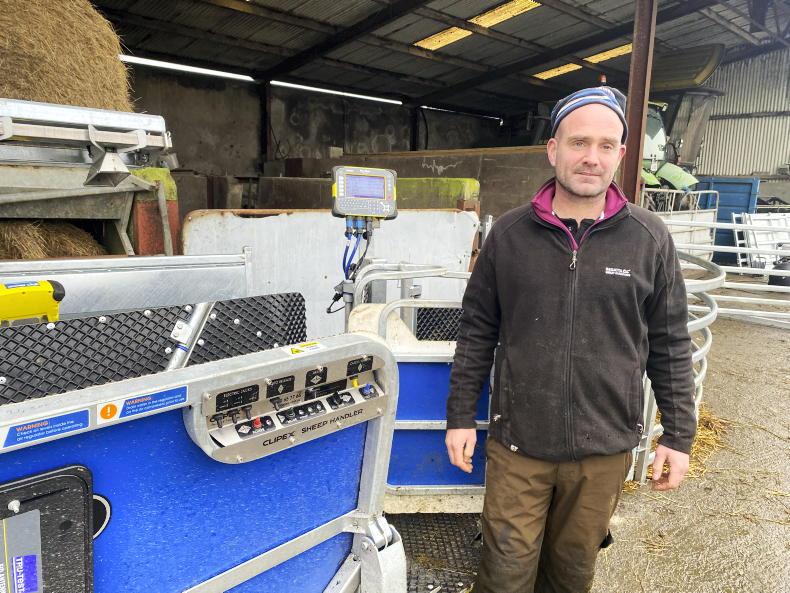
"It's a super machine. The only disappointment with it is the poor reference cost under TAMS 3 for such a high spec machine," stated Frankie.
While a relatively good handling unit with a round pen and manual drafting unit is in situ on farm, Frankie wished to further automate the system and reduce man hours in drafting and treating sheep.
He also looked to increasing the amount of information on liveweight gain and kill out percentages.
For this reason, Frankie took a Clipex Contractor model sheep handling unit. The Clipex sheep handler was sourced from Clipex Ireland, based in Ennis, Co Clare, who are the European headquarters for Clipex.
The model
Clipex sheep handlers come in two different models. The base model does not include the tilt function as standard and is a fixed model, with a pallet fork needed to move the model around a farm/yard.
The Contractor model, which Frankie had on trial, is a trailed model with a single axle and drawbar as well as the catch and tilt function as standard.
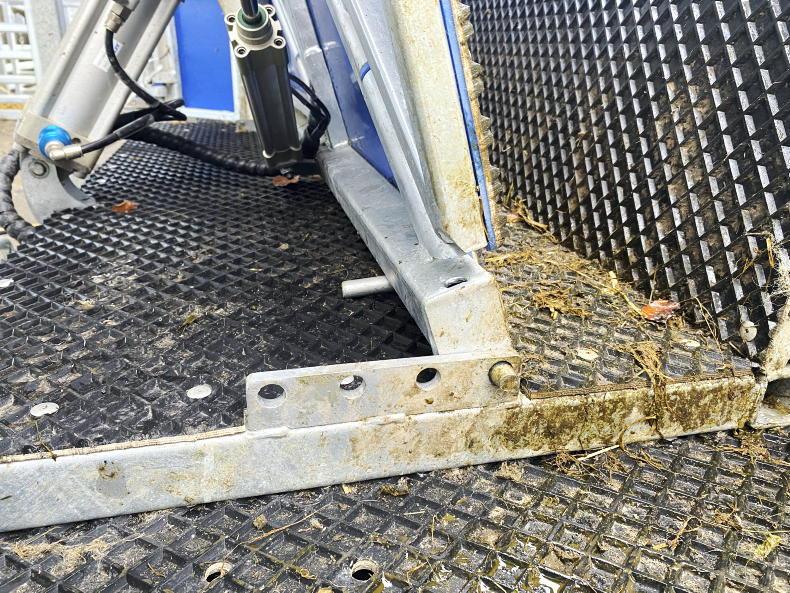
There are four different width settings for the handler, depending on the size of the sheep.
The system can be set up in three settings: automatic, semi-automatic and manual. Frankie used the automatic function most often – this automatically caught, weighed and drafted the sheep based on the preselected weights chosen by Frankie.
Three-way automatic drafting is standard, though five-way drafting can also be specified. The semi-automatic setting catches the sheep and allows the farmer to choose which way they are drafted through the hand held remote.
“When I was splitting ewes earlier in the year for putting in the rams, this function was great, I could stand in the chute to load ewes while the machine caught them and I could then manually draft them depending on what ram I wanted to join them with,” said Frankie.
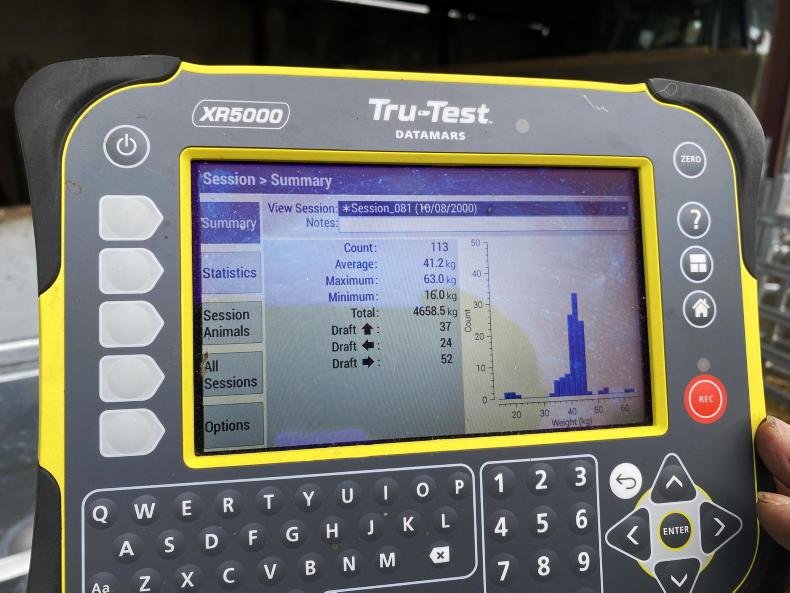
A sample of the information from drafting a bunch of lambs through the crate including head count, average, maximum and minimum weights.
As one sheep is held in the crate itself, the sheep coming up behind is held on the ramp. When the sheep in front is released, the sheep on the ramp moves forward to the crate and is caught either automatically or manually, and the vacated space on the ramp is filled by the next lamb in line.
All this leads to a smooth and quick system for handling sheep.
Tracking performance
The weigh system, which was Tru-Test in the trialled model but can also be specified with a Gallagher system, comes with a built in EID tag reader.
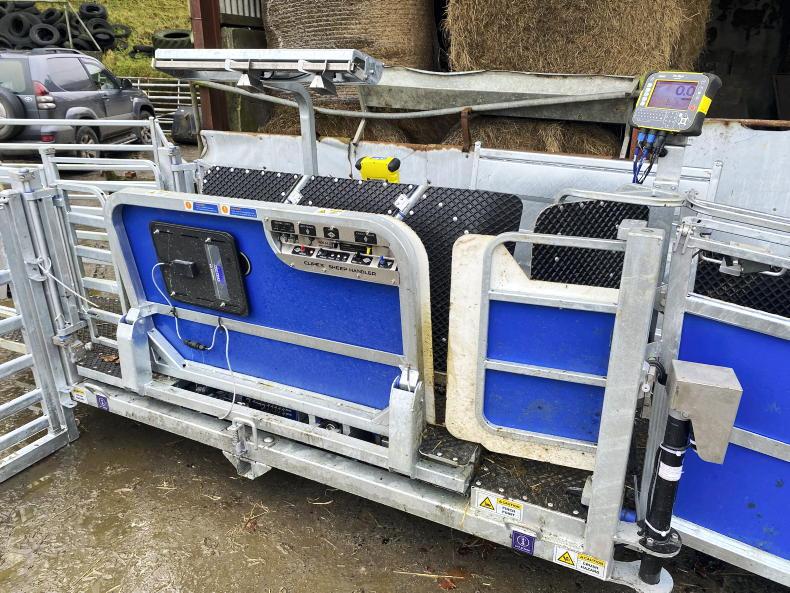
Weighing 750kg, the system is powered by a 12-volt battery with an air compressor connected for the pneumatic rams.
All the information the system picks up is then recorded and can be sent via Bluetooth to the farmer’s phone and then uploaded online.
On the day the Irish Farmers Journal visited Frankie, he was weighing and drafting a bunch of lambs into three weight bands. The system can immediately provide a head count, along with the average, minimum and
maximum weights.
When uploaded on the laptop, Frankie can also see average daily liveweight gain for each individual lamb, something that interests him greatly.
“We have our own theories here as to how long it takes lambs to adjust to the forage crops, and we feel that kale leads to better lamb performance than redstart. It would be great to be able to track
performance and see accurately what the effects are on liveweight gain.
“For us, buying in from 25 or so farmers, it would be also be beneficial to track the performance of lambs from individual farms. If we could see that liveweight gains from a certain farm weren’t performing equal to other lambs, we could avoid buying from this farm in the future.’’
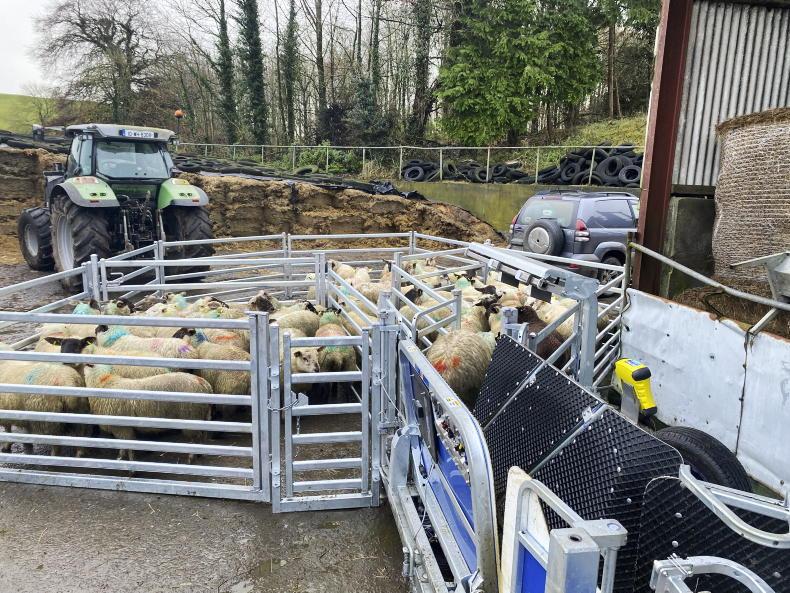
Frankie drafted lambs into three groups depending on weight on the day of our visit.
Automatic drafting is not limited to weight. Drafting can be carried out depending on breed, sex, sire, lactation or in to preselected mobs once this information has been preregistered on the system and assigned to the animal’s EID tag number.
Catch and tilt
The rubber surface inside the crate is designed to slow down and grip on to the sheeps’ wool as they pass through, allowing the crate to automatically catch the sheep. In manual mode, the farmer does the catching.

The handler can be set to automatically catch and hold a sheep for treatment. This treatment can then be recorded on the system.
There are four different pressure settings on the crate, as well as an additional four different settings at the base of the outer flap to widen or narrow the width of the crate as required depending on sheep size.
For horned sheep, the front flap can be permanently held back by use of a simple bracket so that no pressure is placed on the horns, while the sheep can still easily be caught.
A function on the Contractor model is the tilt function, where the crate turns the sheep over 90° to allow the farmer to carry our treatments.
The rear flap can be tilted back to give access for dagging while the front flap allows for access to the head for blousing or drenching.
“I didn’t use the tilt for dosing to be honest,’’ said Frankie. “I just moved the sensors above the crate forward slightly. This meant that the ewe was caught further forward in the crate and I was able to bolus or drench while they were clamped standing up.”
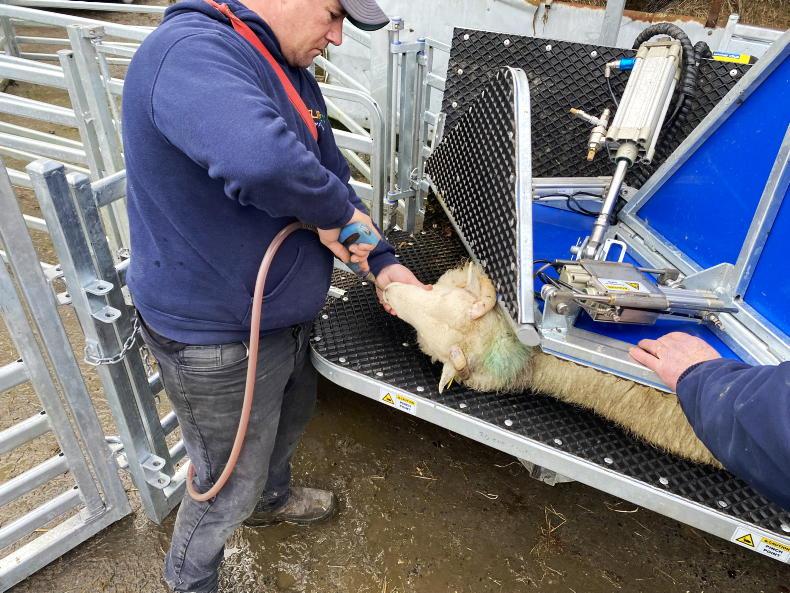
A flap to the front can give access for vaccination of drenching if needed.
The unit itself is powered by a 12-volt battery and a small compressor, with the catching and tilting functions of the crate and the drafting gates done through pneumatic rams.
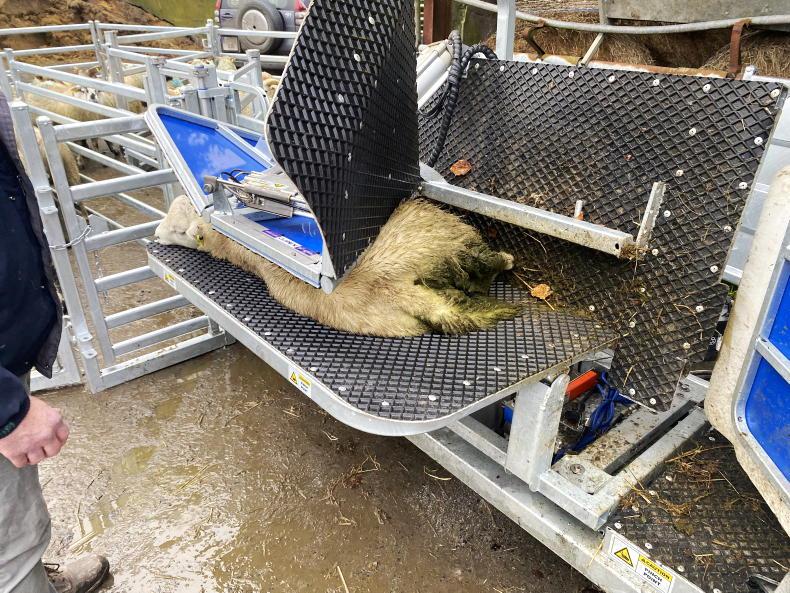
Once the lamb is tilted back, the rear flap can be folded back for ease of access for dagging.
To allow for the removal and reattachment of the wheels for transport, there are several rams that lift and lower the crate, which can also be used to adjust the crate for use depending on the operator’s height.
The drafting gate to the front and the loading ramp to the rear all fold back in to the crate for ease of transport, with the crate transformed in to transport mode in a matter of minutes.
The machine itself is made of galvanised high tensile steel for longevity, with all the electrical components safely tucked in underneath to prevent damage. The drafting gates and gates on the rear ramp are aluminium. Gross weight of the machine is 820kg.
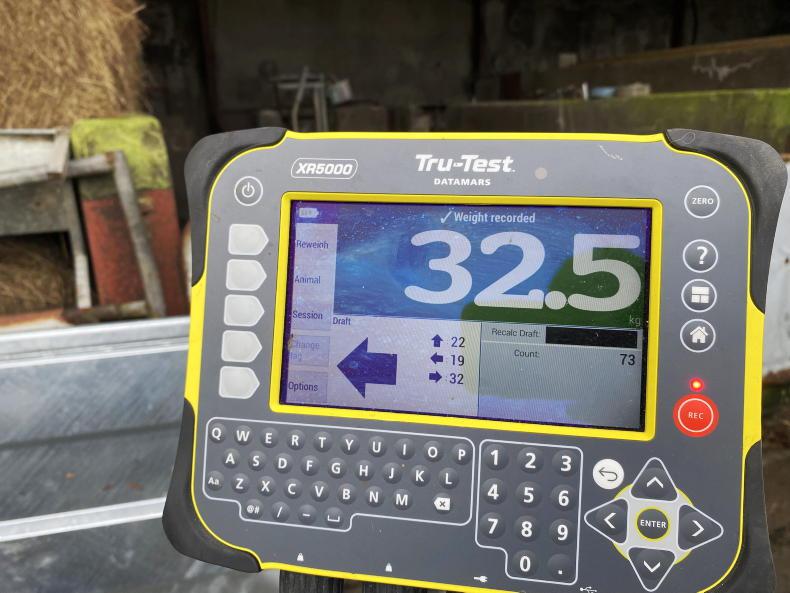
The Tru Test weigh system displaying the animal weight and where it is to be drafted (left arrow).
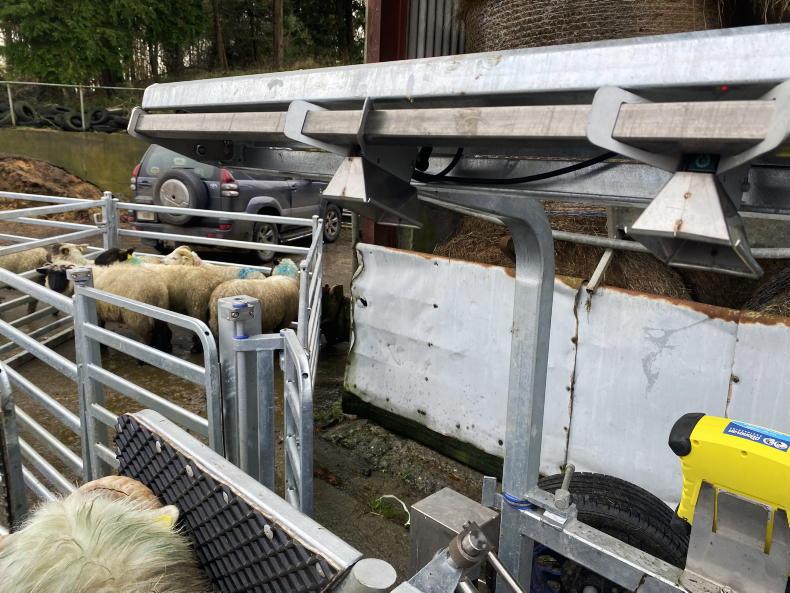
Two sensors over the crate read the EID tag of the sheep, and can be adjusted to forwards or back to change the position the sheep is caught in the crate.
Farming outside Castlepollard,
Co Westmeath, Frankie Boyhan and his father run a typical Midlands mixed enterprise system, with the tillage enterprise being complemented by finishing purchased store cattle and lambs.
Between 700 and 800 store lambs are purchased each year from throughout the country, with kale and other forage crops grown to finish lambs without concentrates.
Similar to many farmers, albeit on a slightly larger scale, animal handling is one of the main labour inputs on the store lamb enterprise.
Dosing, vaccination, dagging and frequent drafting of lambs for slaughter are time-consuming and laborious exercises that Frankie must undertake.

"It's a super machine. The only disappointment with it is the poor reference cost under TAMS 3 for such a high spec machine," stated Frankie.
While a relatively good handling unit with a round pen and manual drafting unit is in situ on farm, Frankie wished to further automate the system and reduce man hours in drafting and treating sheep.
He also looked to increasing the amount of information on liveweight gain and kill out percentages.
For this reason, Frankie took a Clipex Contractor model sheep handling unit. The Clipex sheep handler was sourced from Clipex Ireland, based in Ennis, Co Clare, who are the European headquarters for Clipex.
The model
Clipex sheep handlers come in two different models. The base model does not include the tilt function as standard and is a fixed model, with a pallet fork needed to move the model around a farm/yard.
The Contractor model, which Frankie had on trial, is a trailed model with a single axle and drawbar as well as the catch and tilt function as standard.

There are four different width settings for the handler, depending on the size of the sheep.
The system can be set up in three settings: automatic, semi-automatic and manual. Frankie used the automatic function most often – this automatically caught, weighed and drafted the sheep based on the preselected weights chosen by Frankie.
Three-way automatic drafting is standard, though five-way drafting can also be specified. The semi-automatic setting catches the sheep and allows the farmer to choose which way they are drafted through the hand held remote.
“When I was splitting ewes earlier in the year for putting in the rams, this function was great, I could stand in the chute to load ewes while the machine caught them and I could then manually draft them depending on what ram I wanted to join them with,” said Frankie.

A sample of the information from drafting a bunch of lambs through the crate including head count, average, maximum and minimum weights.
As one sheep is held in the crate itself, the sheep coming up behind is held on the ramp. When the sheep in front is released, the sheep on the ramp moves forward to the crate and is caught either automatically or manually, and the vacated space on the ramp is filled by the next lamb in line.
All this leads to a smooth and quick system for handling sheep.
Tracking performance
The weigh system, which was Tru-Test in the trialled model but can also be specified with a Gallagher system, comes with a built in EID tag reader.

Weighing 750kg, the system is powered by a 12-volt battery with an air compressor connected for the pneumatic rams.
All the information the system picks up is then recorded and can be sent via Bluetooth to the farmer’s phone and then uploaded online.
On the day the Irish Farmers Journal visited Frankie, he was weighing and drafting a bunch of lambs into three weight bands. The system can immediately provide a head count, along with the average, minimum and
maximum weights.
When uploaded on the laptop, Frankie can also see average daily liveweight gain for each individual lamb, something that interests him greatly.
“We have our own theories here as to how long it takes lambs to adjust to the forage crops, and we feel that kale leads to better lamb performance than redstart. It would be great to be able to track
performance and see accurately what the effects are on liveweight gain.
“For us, buying in from 25 or so farmers, it would be also be beneficial to track the performance of lambs from individual farms. If we could see that liveweight gains from a certain farm weren’t performing equal to other lambs, we could avoid buying from this farm in the future.’’

Frankie drafted lambs into three groups depending on weight on the day of our visit.
Automatic drafting is not limited to weight. Drafting can be carried out depending on breed, sex, sire, lactation or in to preselected mobs once this information has been preregistered on the system and assigned to the animal’s EID tag number.
Catch and tilt
The rubber surface inside the crate is designed to slow down and grip on to the sheeps’ wool as they pass through, allowing the crate to automatically catch the sheep. In manual mode, the farmer does the catching.

The handler can be set to automatically catch and hold a sheep for treatment. This treatment can then be recorded on the system.
There are four different pressure settings on the crate, as well as an additional four different settings at the base of the outer flap to widen or narrow the width of the crate as required depending on sheep size.
For horned sheep, the front flap can be permanently held back by use of a simple bracket so that no pressure is placed on the horns, while the sheep can still easily be caught.
A function on the Contractor model is the tilt function, where the crate turns the sheep over 90° to allow the farmer to carry our treatments.
The rear flap can be tilted back to give access for dagging while the front flap allows for access to the head for blousing or drenching.
“I didn’t use the tilt for dosing to be honest,’’ said Frankie. “I just moved the sensors above the crate forward slightly. This meant that the ewe was caught further forward in the crate and I was able to bolus or drench while they were clamped standing up.”

A flap to the front can give access for vaccination of drenching if needed.
The unit itself is powered by a 12-volt battery and a small compressor, with the catching and tilting functions of the crate and the drafting gates done through pneumatic rams.

Once the lamb is tilted back, the rear flap can be folded back for ease of access for dagging.
To allow for the removal and reattachment of the wheels for transport, there are several rams that lift and lower the crate, which can also be used to adjust the crate for use depending on the operator’s height.
The drafting gate to the front and the loading ramp to the rear all fold back in to the crate for ease of transport, with the crate transformed in to transport mode in a matter of minutes.
The machine itself is made of galvanised high tensile steel for longevity, with all the electrical components safely tucked in underneath to prevent damage. The drafting gates and gates on the rear ramp are aluminium. Gross weight of the machine is 820kg.

The Tru Test weigh system displaying the animal weight and where it is to be drafted (left arrow).

Two sensors over the crate read the EID tag of the sheep, and can be adjusted to forwards or back to change the position the sheep is caught in the crate.















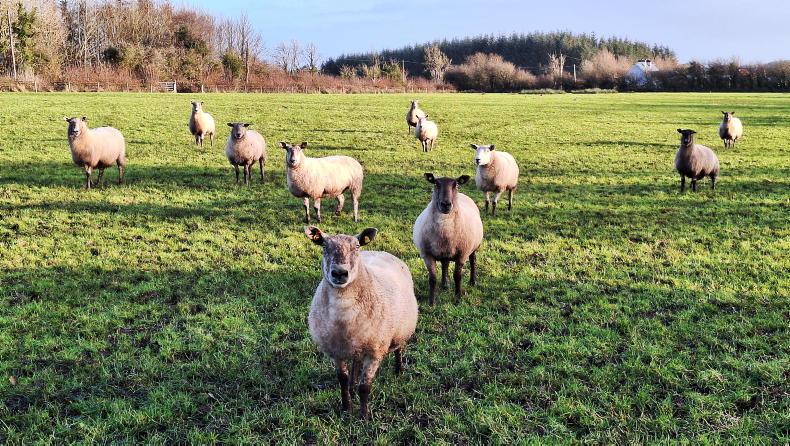


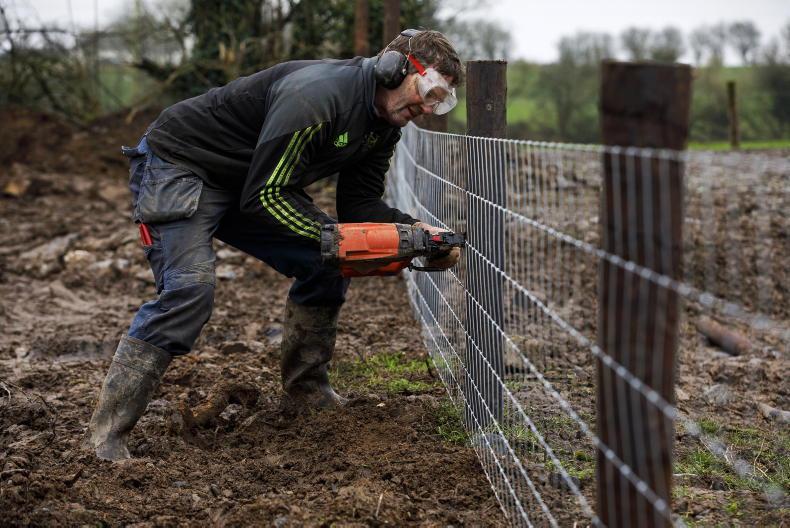
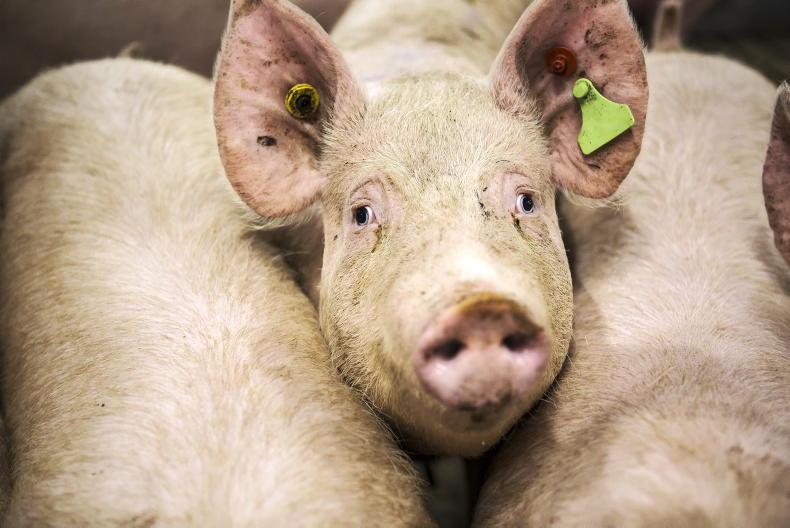
SHARING OPTIONS